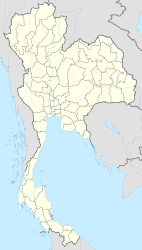Phrae
|
แพร่ Phrae |
||
|---|---|---|
|
|
||
| Coordinates | 18 ° 9 ′ N , 100 ° 9 ′ E | |
| Basic data | ||
| Country | Thailand | |
| Phrae | ||
| ISO 3166-2 | TH-54 | |
| Residents | 18,000 | |
Phrae ( Thai : แพร่ ; Lanna : แป้ , Pae ) is the capital of the Phrae Province in the northern region of Thailand . It is located in the district ( Amphoe ) Mueang Phrae and has the administrative status of a city municipality (Thesaban Mueang) .
The city of Phrae has 16,970 inhabitants (as of 2012).
geography
Phrae is located about 550 kilometers north of Bangkok , in the valley of the Mae Nam Yom ( Yom River ), which flows into the Mae Nam Chao Phraya . The city is surrounded by picturesque mountains, it is located in the middle of a small central plain, which after the construction of the Yom Dam is mainly used for rice cultivation .
The old town is surrounded by a completely preserved city wall, the moat is fed by the Huai Mae Khaem river, which flows into the Maenam Yom in the northwest. Four historical city gates have been preserved, leading out of the city in the four directions: Pratu Sri Chum in the north, Pratu Mai in the east, Pratu Chai in the south and Pratu Man in the west.
economy
Like Lampang, Phrae became the center of the teak industry in the 19th century . Even today there are a large number of teak houses, the architectural style of many Buddhist temples ( wat ) is Burmese, as many wood merchants from Burma settled here.
Today rice cultivation is an important source of income. The manufacture of rattan furniture and textiles is also important , especially the work shirt made of coarsely woven blue cotton fabric.
history
Phrae is one of the oldest city foundations in Thailand, dating back to the eleventh century when it was founded by the Mon as part of the Hariphunchai kingdom . The historic shape of the city, an oval with earth walls and a city moat, can still be seen today, so it resembles city foundations from the same time: Lamphun and Lampang .
As an independent principality, it was also known as Wiang Kosai. For King Mangrai , the capture of the small, previously independent city-state of Phrae was the first expansion of his kingdom of Lan Na . Eventually it fell to the kingdom of Sukhothai as part of King Ramkhamhaeng's expansion policy .
Attractions
- City wall - almost completely preserved, partly reconstructed
- City Museum - hand axes from the 3rd century BC BC, solid golden Buddha head, palm leaf books of the Mon
- City Pillar ( Lak Mueang ) - a gilded wooden pillar in an ornate pavilion, similar to that in Lampang, indicating the geographical city center. ⊙
- Wat Luang ( วัดหลวง ) - temple from the 14th century with Burmese style elements, in which the monks recite from palm leaf books. ⊙
- Wat Chom Sawan ( วัด จอม สวรรค , monastery of the highest heaven ) - the most beautiful example of Burmese temple architecture in northern Thailand, built between 1910 and 1912. It is located northeast just outside the old city. ⊙
- Wat Phrathat Cho Hae ( วัด พระ ธาตุ ช่อ แฮ ) - Buddhist temple ( Wat ) from the early 14th century , around ten kilometers southwest of Phrae in the northern Thai-Burmese style, with a very revered Buddha statue ; the pagoda ( chedi ) is approx. 33 meters high and completely coated with gold leaf. In Thai folk Buddhism, it is a popular pilgrimage destination for people born in the year of the tiger. ⊙
- Phae Mueang Phi ( วนอุทยาน แพะ เมือง ผี ) - nature experience in the form of impressive eroded rock formations, which some locals suspect are inhabited by ghosts (Mueang Phi means something like "place of ghosts")
Local festivals
- Prathat Cho Hae Festival - February or March, traditional style processions, performances by local artists
- Salak Luang - November, traditional style processions with the colorful local robes and music with competition in traditional dances; the devout Buddhists consecrate gifts that they bring to the monks of Wat Luang
literature
- Michael Freeman: Lanna - Thailand's Northern Kingdom . River Books, Bangkok 2001, ISBN 0-500-97602-3
Web links
- City map of Phrae (names in Thai and English) [last accessed on November 11, 2013]



